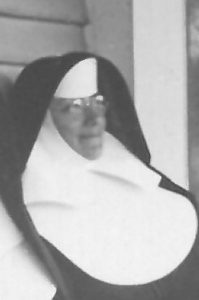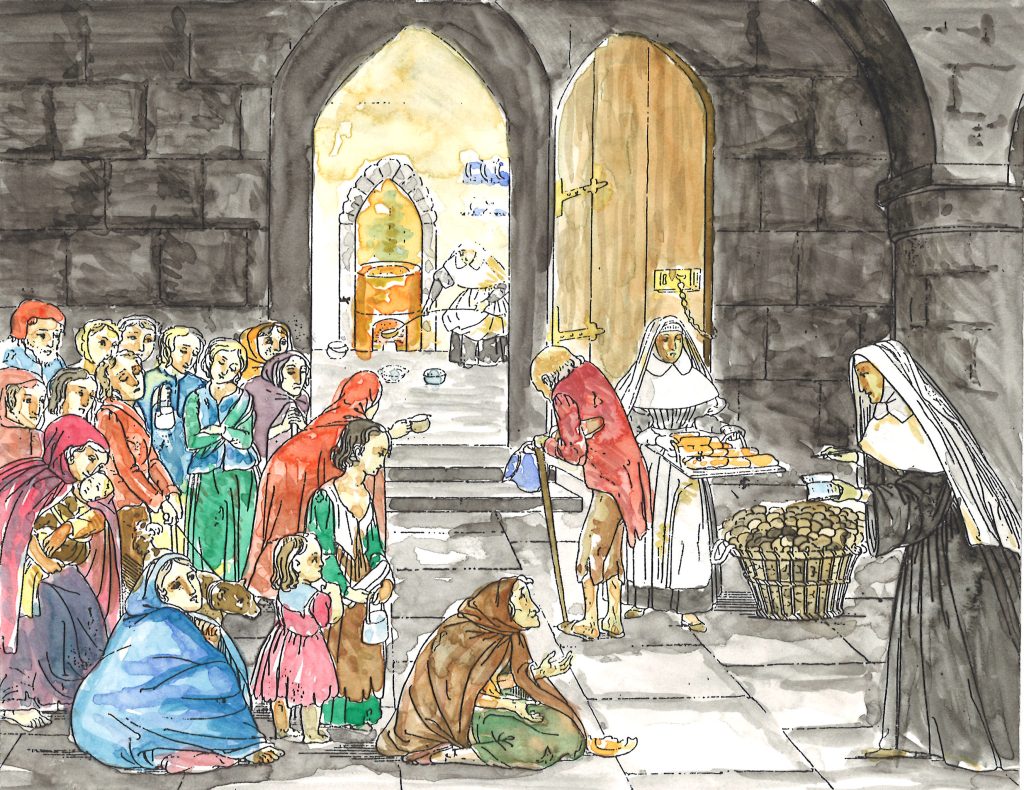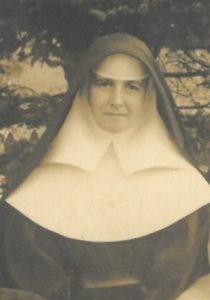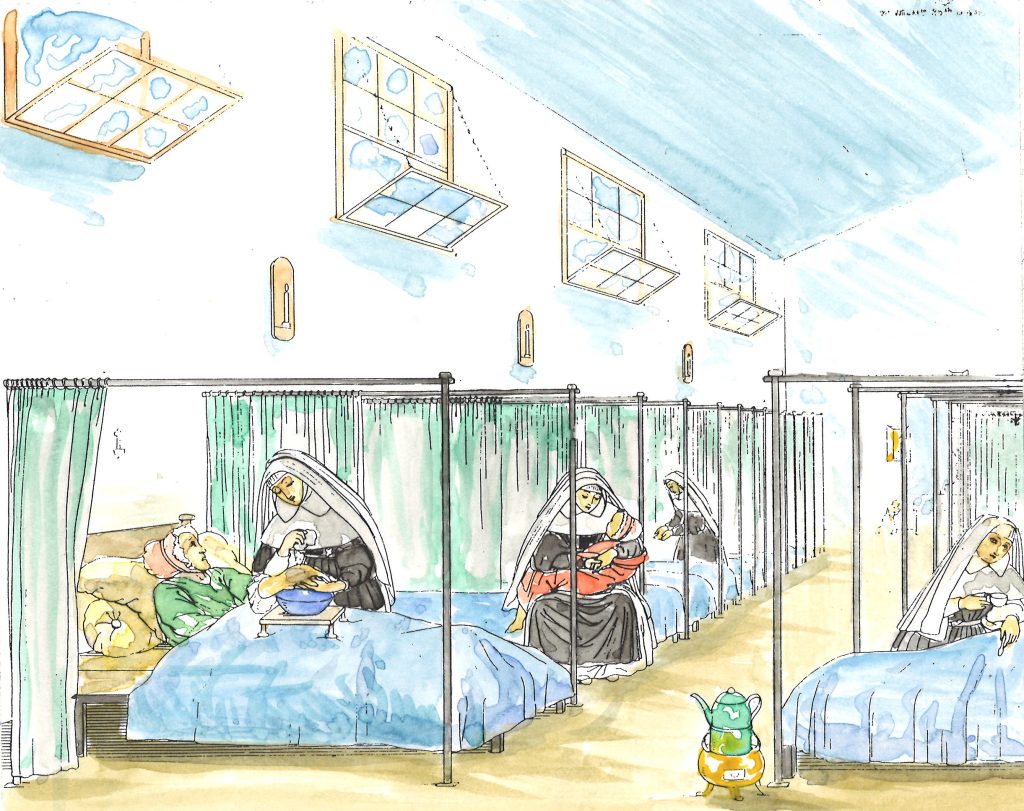Elizabeth Davis, daughter of Anastasia Flannigan and John Davis was born on Bell Island in September 1887. When she was very young her father died and she was placed in St. Michael’s Orphanage, Belvedere. From there she was adopted by a family named McDermott. Her early education took place at Our Lady of MercyAcademy.
 At the age of 20 Elizabeth entered the Sisters of Mercy at Mercy Convent on Military Road and was given the name Sister Mary Baptist at her reception into the novitiate.
At the age of 20 Elizabeth entered the Sisters of Mercy at Mercy Convent on Military Road and was given the name Sister Mary Baptist at her reception into the novitiate.
Her exceptional musical abilities were evident from her earliest years. Her superiors at Mercy Convent recognized her extraordinary talent, and after her profession in August of 1909, engaged for her the finest music teachers in St. John’s. Later she was given the opportunity to study at the Boston Conservatory of Music where her studies included piano, harp, orchestration and harmony. She also spent several summers studyingGregorian Chant at Manhattanville, New York. With the exception of her study times in the United States, Sister M. Baptist’s entire religious life was spent at Mercy Convent.
In 1921, Sister M. Baptist, with the assistance of Sister M. Bridget O’Connor, organized the orchestra at Mercy Convent, the first of its kind in Newfoundland. The orchestra made its first appearance on October 12 1921 at the opening of the Knights of Columbus Memorial School (now The Gathering Place). Its first performance outside the school took place at the Casino Theatre on Henry Street in 1923. Sister M. Baptist was known throughout the city as an outstanding music and drama teacher and herstage productions were noted for artistic perfection in every detail.
In September of 1949 Sister M. Baptist went to Boston for medical reasons and underwent surgery at Carney Hospital, operated by the Sisters of Charity. She was about to return home in April 1950 when she became seriously ill and died on April 30. She was waked at the Convent of Mercy in Providence, Rhode Island and buried in the sisters’ cemetery. It is interesting that the superior of that convent was Sister M. Amabilis Baker, sister of Sister M. Magdalen Baker of St. Clare’s Mercy Hospital and aunt of Sister Mary Baker.
Sister M. Baptist’s unexpected death was a great loss for the sisters, for her pupils and for the city of St. John’s. With all her musical talent and successes, she was a retiring individual with a special predilection for the underprivileged. Her obituary notes that she had a cheerful disposition, a kind and generous heart, a keen sense of humor and a well-informed mind, all of which made her “a genial companion and a pleasant conversationalist.”
Elizabeth Davis, hija de Anastasia Flannigan y John Davis, nació en Bell Island en septiembre de 1887. Cuando era muy pequeña murió su padre y fue internada en el orfanato St. Michael’s de Belvedere. Desde allí fue adoptada por una familia llamada McDermott. Su primera educación tuvo lugar en la Academia de Nuestra Señora de la Merced.
A la edad de 20 años, Elizabeth ingresó en el convento de las Hermanas de la Misericordia, en Military Road, y recibió el nombre de Hermana Mary Baptist al ser recibida en el noviciado.
Sus excepcionales habilidades musicales fueron evidentes desde sus primeros años. Sus superioras del Convento de la Misericordia reconocieron su extraordinario talento y, tras su profesión en agosto de 1909, contrataron para ella a los mejores profesores de música de St. Más tarde tuvo la oportunidad de estudiar en el Conservatorio de Música de Boston, donde estudió piano, arpa, orquestación y armonía. También pasó varios veranos estudiando canto gregoriano en Manhattanville, Nueva York. Con la excepción de sus períodos de estudio en los Estados Unidos, la Hermana M. Baptist pasó toda su vida religiosa en el Convento de la Misericordia.
En 1921, la Hermana M. Baptist, con la ayuda de la Hermana M. Bridget O’Connor, organizó la orquesta en el Convento de la Misericordia, la primera de su clase en Terranova. La orquesta hizo su primera aparición el 12 de octubre de 1921 en la inauguración de la Knights of Columbus Memorial School (ahora The Gathering Place). Su primera actuación fuera de la escuela tuvo lugar en el Casino Theatre de Henry Street en 1923. La Hermana M. Baptist era conocida en toda la ciudad como una destacada profesora de música y teatro y sus producciones escénicas destacaban por la perfección artística en cada detalle.
En septiembre de 1949, la Hermana M. Baptist viajó a Boston por razones médicas y se sometió a una operación en el Hospital Carney, operado por las Hermanas de la Caridad. Estaba a punto de regresar a casa en abril de 1950 cuando enfermó gravemente y murió el 30 de abril. Fue velada en el Convento de la Misericordia de Providence, Rhode Island, y enterrada en el cementerio de las hermanas. Es interesante que la superiora de ese convento fuera la hermana M. Amabilis Baker, hermana de la hermana M. Magdalen Baker del Hospital de la Misericordia de Santa Clara y tía de la hermana Mary Baker.
La inesperada muerte de la hermana M. Baptist fue una gran pérdida para las hermanas, para sus alumnas y para la ciudad de St. Con todo su talento musical y sus éxitos, era una persona retraída con especial predilección por los desfavorecidos. Su obituario señala que tenía un carácter alegre, un corazón bondadoso y generoso, un agudo sentido del humor y una mente bien informada, todo lo cual hacía de ella «una compañera genial y una agradable conversadora».


 Mary entered the Sisters of Mercy at Mercy Convent in 1914, was received into the novitiate as Sister Mary Alphonsus in 1915 and was professed on July 8, 1917, along with Sister M. Aloysius Rawlins. Her first mission took her to St. Edward’s Convent on Bell Island as a member of the founding community in September of 1917. From there she went to St. Anne’s Convent in Burin and in 1927 returned to Bell Island to join the founding community of Immaculate Conception Convent. From 1928 to 1934 she was superior of St. Mary’s on the Humber Convent in Curling, where she was noted for her dedication to visitation of the sick in their homes. In this ministry she was said to have washed patients, changed bed linens and did other chores to make the person more comfortable. Sisters in the community remember that on one occasion when a person in the parish died, she prepared the body for burial.
Mary entered the Sisters of Mercy at Mercy Convent in 1914, was received into the novitiate as Sister Mary Alphonsus in 1915 and was professed on July 8, 1917, along with Sister M. Aloysius Rawlins. Her first mission took her to St. Edward’s Convent on Bell Island as a member of the founding community in September of 1917. From there she went to St. Anne’s Convent in Burin and in 1927 returned to Bell Island to join the founding community of Immaculate Conception Convent. From 1928 to 1934 she was superior of St. Mary’s on the Humber Convent in Curling, where she was noted for her dedication to visitation of the sick in their homes. In this ministry she was said to have washed patients, changed bed linens and did other chores to make the person more comfortable. Sisters in the community remember that on one occasion when a person in the parish died, she prepared the body for burial. The following year Katie applied to enter the Sisters of Mercy. She was accepted as a postulant and at her Reception into the Novitiate was given the name Sister Mary Borgia. The community at Mercy Convent did not deem her strong enough to carry out the arduous duties of the Motherhouse and named her to the St. Lawrence community. She made Profession of Vows at St. Lawrence and remained therefor the rest of her life in generous, dedicated service to the community.
The following year Katie applied to enter the Sisters of Mercy. She was accepted as a postulant and at her Reception into the Novitiate was given the name Sister Mary Borgia. The community at Mercy Convent did not deem her strong enough to carry out the arduous duties of the Motherhouse and named her to the St. Lawrence community. She made Profession of Vows at St. Lawrence and remained therefor the rest of her life in generous, dedicated service to the community. Bridget taught at St. Bride’s for four years before entering the Sisters of Mercy in January 1917. She was received into the novitiate as Sister Mary Augustine in July of that same year and was professed in July of 1919.
Bridget taught at St. Bride’s for four years before entering the Sisters of Mercy in January 1917. She was received into the novitiate as Sister Mary Augustine in July of that same year and was professed in July of 1919. During her eight years at Mercy Convent, Sister Mary Joseph studied music under the direction of Professor Thomas Mullock, brother of Bishop Mullock and the first organist at the Cathedral of St. John the Baptist. She was the aunt of Sister M. Aloysius Rawlins who played such a significant role in the early days of St. Clare’s Mercy Hospital.
During her eight years at Mercy Convent, Sister Mary Joseph studied music under the direction of Professor Thomas Mullock, brother of Bishop Mullock and the first organist at the Cathedral of St. John the Baptist. She was the aunt of Sister M. Aloysius Rawlins who played such a significant role in the early days of St. Clare’s Mercy Hospital. These two great women of Mercy faithfully carried out the works of Mercy as if there were dozens of sisters in the Newfoundland Mercy community – continuing in school and visiting the sick and poverty-stricken in their homes and in St. John’s Hospital (located near present-day Victoria Park). In June of 1947 when St. John’s was in the throes of a severe typhus epidemic, they closed school and devoted themselves entirely to visiting and caring for the sick. It was at St. John’s Hospital that Sister M. Joseph caught the dreaded fever from a young seaman who was suffering great physical and spiritual anguish. Despite the medical services of physicians and the loving care of Sister M. Francis, Sister M. Joseph died after two weeks of suffering the torments of the disease. She was 48 years of age and had only been a Sister of Mercy for four years.
These two great women of Mercy faithfully carried out the works of Mercy as if there were dozens of sisters in the Newfoundland Mercy community – continuing in school and visiting the sick and poverty-stricken in their homes and in St. John’s Hospital (located near present-day Victoria Park). In June of 1947 when St. John’s was in the throes of a severe typhus epidemic, they closed school and devoted themselves entirely to visiting and caring for the sick. It was at St. John’s Hospital that Sister M. Joseph caught the dreaded fever from a young seaman who was suffering great physical and spiritual anguish. Despite the medical services of physicians and the loving care of Sister M. Francis, Sister M. Joseph died after two weeks of suffering the torments of the disease. She was 48 years of age and had only been a Sister of Mercy for four years.